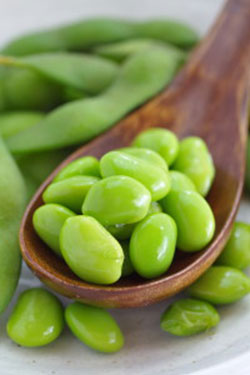By Melissa Wdowik
Food Science and Human Nutrition Professor
April 3, 2015

Recently, a friend called my husband to inquire about the risks for men in consuming too much soy milk. He had read an article that described how one individual’s plight led him down the path of breast enlargement, and was concerned. This question caused me to want to explore soy milk in greater detail.
Gynecomastia, or the growth of abnormally large breasts in males, is caused by a change in hormone levels and how the body responds to them. Possible contributing factors include aging (1 in 4 men over the age of 50); alcohol, steroid or marijuana use; plant oils such as lavender; and some medications and medical treatments. The change in hormone levels has also been attributed to dietary soy, although there is little in the scientific literature to support this idea.
The reason for the proposed link lies in the structure of soy. Soy contains isoflavones, which are converted in the body to phytoestrogens, similar to human estrogen that occurs naturally in both men and women. Theoretically, a high isoflavone intake could stimulate production of estrogen and decrease production of testosterone, with one result being enlarged breast tissue. A publication in 2008 told the story of a man who developed large breasts due to the consumption of soy milk, and was further circulated in blog posts urging men to avoid all soy sources. What is often lost in the telling is the amount of soy milk consumed: three quarts (12 cups) every day! Remember what I have told you about moderation.
So, is soy beneficial and safe for men? On the one hand, whole soy foods (soybeans vs. foods with added soy protein isolate) are high in fiber and protein while low in saturated fat. They show potential to protect against prostate cancer, and fears about lowered fertility and increased female features have not held up in research studies. On the other hand, the long-term safety of high doses of soy isoflavones is not yet known and long-term studies are needed. Beware of sports products and snack bars, as many of them contain soy to boost protein content, and it is easy to get too much; limit intake to one per day, if any. Stick with 1 to 2 servings of whole soy foods (1 serving = 1 cup soy milk, ½ cup cooked soy beans, ½ cup edamame, 1 ounce soy nuts or 2 ounce tofu).
Avoid soy supplements. Most experts advise against supplementing with soy until more research is conducted. Besides, fewer than 25 percent of soy supplements have been found to contain what the label indicates, and supplement safety is not tested.
Now that I’ve started the soy discussion, stay tuned for the next article in this series as I discuss the pros and cons for women, then compare soy products to similar non-soy products such as milks and meat substitutes.
Melissa Wdowik, PhD, RDN, is an assistant professor at Colorado State University in the Department of Food Science and Human Nutrition, and director of the Kendall Anderson Nutrition Center.





